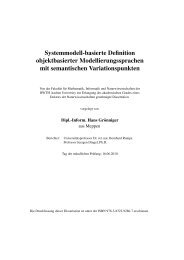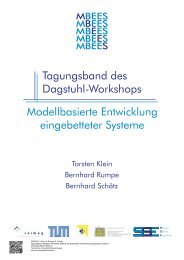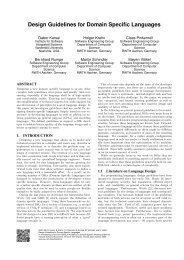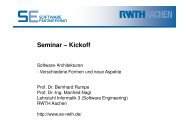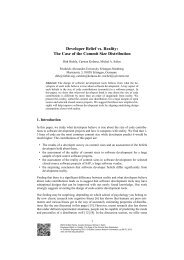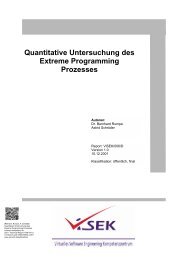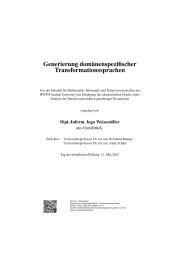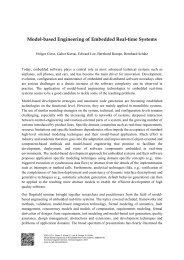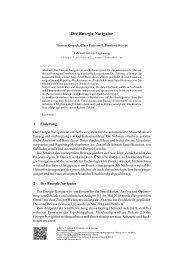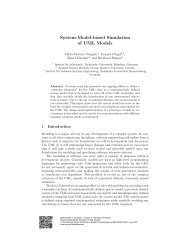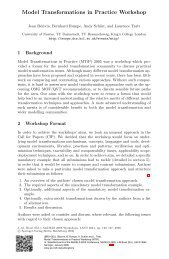Semantic Differencing for Activity Diagrams - Software Engineering
Semantic Differencing for Activity Diagrams - Software Engineering
Semantic Differencing for Activity Diagrams - Software Engineering
You also want an ePaper? Increase the reach of your titles
YUMPU automatically turns print PDFs into web optimized ePapers that Google loves.
• V inp is a (possibly empty) set of immutable input variables<br />
over finite domains.<br />
• V loc is a (possibly empty) set of local variables over<br />
finite domains.<br />
• AN is a set of action nodes an 1, . . . , an k . Each action<br />
node an is labeled with an action name acname(an) =<br />
ac ∈ A, and a (possibly empty) set of assignment expressions<br />
to the variables in V loc .<br />
• P N is a set of pseudo nodes, consisting of initial nodes<br />
P N init , final nodes P N fin , decision nodes P M dec ,<br />
merge nodes P N mer , <strong>for</strong>k nodes P N <strong>for</strong>k , and join<br />
nodes P N join .<br />
• T is a set of transitions of the <strong>for</strong>m t = 〈n src, n trg, guard〉<br />
where n src, n trg ∈ (AN ∪ P N) and guard is a Boolean<br />
expression over the variables in V inp ∪ V loc . Unless<br />
n src is a decision node, guard = true.<br />
We do not <strong>for</strong>mally capture here obvious well-<strong>for</strong>medness<br />
rules and context conditions such as: initial nodes have no<br />
incoming transitions, final nodes have no outgoing transitions,<br />
<strong>for</strong>k nodes must be followed by join nodes to remove<br />
all concurrency when reaching a final node, actions should<br />
not repeat in different <strong>for</strong>ked branches, etc.<br />
In addition, we assume that the Boolean expressions used<br />
as guards on transitions outgoing decision nodes are semantically<br />
exclusive, that is, no assignment to the diagram variables<br />
makes more than one of them true. Thus, the input<br />
variables provide external non-determinism, while except <strong>for</strong><br />
<strong>for</strong>ked branches, our ADs are internally deterministic.<br />
We consider two concrete syntax definitions <strong>for</strong> ADs: a<br />
concrete visual syntax based on UML 2 ADs and a concrete<br />
textual syntax defined using MontiCore [13, 22]. We omit<br />
the concrete syntax definitions from this paper.<br />
The implementation we present in Sect. 5 supports a subset<br />
of full UML 2 ADs: it supports action nodes and pseudo<br />
nodes: initial, final, <strong>for</strong>k, join, decision and merge; each<br />
AD has exactly one initial node but may have multiple final<br />
nodes. For simplicity reasons but without loss of generality,<br />
in our implementation no two pseudo nodes can follow each<br />
other directly. In addition, local and input variables have<br />
to be declared as such in the first action node; all variables’<br />
finite domains need to be given as SMV types or enumerations;<br />
and each local variable needs to be assigned a value<br />
in the first action node. We support Boolean guards specified<br />
in the rich SMV expression language [4]. Assignments<br />
to local variables can be made from any action node using<br />
values from SMV expressions.<br />
3.2 AD Language <strong>Semantic</strong>s<br />
We distinguish operational semantics and trace-based semantics.<br />
The operational semantics is based on the definition<br />
of a state machine step, taking the AD from one state<br />
to another, where a state consists of a set of current action<br />
nodes and an assignment to all input and local variables.<br />
The main idea of our operational semantics is to conceptually<br />
translate each ad ∈ AD into a finite state machine<br />
(FSM). Each state is a configuration containing the values<br />
of all local variables and input variables (recall that variables<br />
range over finite domains), the executed action, and<br />
some extra variables with in<strong>for</strong>mation on the control flow of<br />
the AD. Based on this state and evaluated guards possible<br />
transitions are computed that lead to the next state with an<br />
executed action, possibly changed local variables values, and<br />
a new configuration of the control flow tracking variables.<br />
We <strong>for</strong>mally define the operational semantics using a trans<strong>for</strong>mation<br />
of an AD to a module of SMV, the language of the<br />
SMV model checker [20, 29]. Our translation is inspired by<br />
the work of [7], but extends this previous translation with<br />
support <strong>for</strong> data. The complete translation, together with a<br />
detailed example, appears in a separate document [17].<br />
Local variables assist the AD engineer together with guards<br />
to control the execution sequences of actions, e.g., by defining<br />
loops or activating/disabling branches of decision nodes.<br />
Input variables, in contrast to local variables, are initialized<br />
by the environment and do not change during the run of<br />
an AD. The runs of two ADs are compared with the same<br />
input, i.e., where common input variables of both ADs have<br />
the same values. We consider all possible input values of<br />
both ADs when comparing them.<br />
Our semantics of ADs is rather expressive: it considers<br />
values of input variables to be set by the environment (external<br />
non-determinism). However, we only support internal<br />
non-determinism through interleaved execution of <strong>for</strong>ked<br />
branches, and not through non-deterministic decision nodes;<br />
the current configuration and the next executed action determine<br />
the next configuration. Thus, <strong>for</strong> each assignment<br />
to the input variables there could be many possible executions<br />
due to the interleaving semantics of <strong>for</strong>k nodes.<br />
We define a trace-based semantics that is induced by the<br />
operational semantics. Traces are sequences of states from<br />
the state space of the AD’s FSM.<br />
Definition 1 (AD state). A state of an AD ad is an<br />
assignment to all variables defined in the VAR section of its<br />
SMV module. This includes the last executed node acnode<br />
and its action name ac, the values of variables v ∈ ad.V inp ∪<br />
ad.V loc and the values of control flow tracking variables.<br />
AD states have a finite number of possible successor states<br />
that can be reached within one step. By construction, each<br />
such step executes an action or reaches a final node. We<br />
define the successors of an AD state s as successors(s).<br />
Definition 2 (Successor states). For every AD state<br />
s, successors(s) is the set of AD states reachable from s in<br />
one step of the SMV module.<br />
Each run of an AD starts with an initial state in the initial<br />
node. A sequence of successor states that describe a legal<br />
execution of the AD’s FSM is a trace. A trace from the<br />
initial to a final node of the AD is an accepting trace.<br />
Definition 3 (AD traces). A sequence of AD states<br />
tr = s 0, s 1, . . . , s k of AD ad with s i+1 ∈ successors(s i) and<br />
s 0.acnode ∈ ad.P N init is called a trace. The set of all traces<br />
of an AD ad is denoted by traces(ad). A trace is called an<br />
accepted trace if its last state’s node is a final node of the<br />
AD. The set of all accepted traces of an AD ad is denoted<br />
by acceptedT races(ad).<br />
4. ADDIFF<br />
4.1 Definitions<br />
Given two AD states, s 1 ∈ ad 1 and s 2 ∈ ad 2, we say that<br />
s 1 and s 2 are corresponding, iff the action names and values<br />
of equally named input variables of the two states are the<br />
same. Formally:



